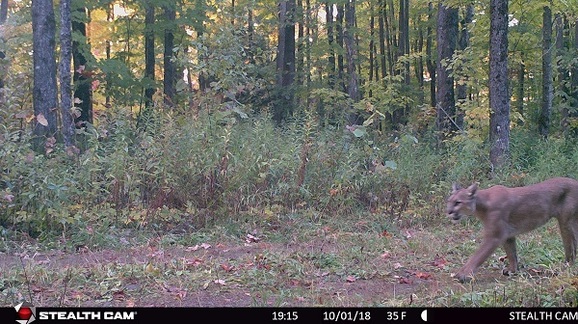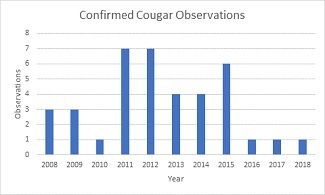 Oct. 25, 2018
Contact: Kevin Swanson, 906-458-1889 or John Pepin, 906-226-1352
 A game camera set up as part of an ongoing state deer movement study has captured images of a cougar in Gogebic County, about 9 miles north of Ironwood.
The images were reviewed and verified by the Michigan Department of Natural Resources’ cougar team.
Since 2008, the DNR has confirmed 38 cougar reports, with all but one of those occurring in the Upper Peninsula. These reports include multiple sightings of the same cougar, not 38 individual animals.
So far, there remains no conclusive evidence of a Michigan breeding population of mountain lions. Cougars are an endangered species in Michigan protected by law.
“This latest confirmed report illustrates just how rare cougars are in the Upper Peninsula,” said Brian Roell, a DNR wildlife biologist in Marquette. “This is the first time we’ve ever caught a cougar on more than three million game camera images we’ve collected in our studies since 2009.”
DNR researchers use game cameras in their Quantifying Upper Peninsula Deer Movements and Abundance, predator-prey and bear studies. The deer movement study alone uses 50 game cameras in the western U.P., including the one in Ironwood Township that caught the images of the cougar at 7:15 p.m. on Oct. 1.
|
 The three daylight photos on the game camera show the mountain lion walking past, from right to left. Biologists noted there was no tracking collar on the cougar. No identification of whether the animal was a male or female was possible.
Michigan cougar confirmations have been derived from trail camera video, photographs, tracks, scat, or in the case of two male cats poached, carcasses.
Previous genetic testing on tissue samples from those two cougars poached in the U.P. showed the two animals likely came from a population found generally in South Dakota, Wyoming and northwest Nebraska.
|
“This genetic research lines up with what we’ve presumed previously, that cougars found in the Upper Peninsula are males dispersing from this population east of the Rocky Mountains,” said Kevin Swanson, a DNR wildlife management specialist with the department’s Bear and Wolf Program. “These males dispersed from the main population are looking to establish new territories.”
Researchers investigated the potential population of origin for the two cougars using a database that includes samples from cougar populations in South Dakota, North Dakota, Nebraska, Montana, Wyoming, Colorado, New Mexico, Arizona, Texas, Oregon and Florida.
According to the U.S. Fish and Wildlife Service, cougars were once the most widely distributed land animal in the Western Hemisphere but have been eliminated from about two-thirds of their historic range.
At one time, cougars lived in every eastern state in a variety of habitats, including coastal marshes, mountains and forests. They were native to Michigan, but were trapped and hunted from the state around the turn of the 20th century.
To learn more about cougars in Michigan, visit michigan.gov/cougars.
/Note to editors: Accompanying photos are available below for download. a suggested caption follows. Credit: Michigan Department of Natural Resources.
Cougar-1 and Cougar-2: This mountain lion was caught on a Michigan Department of Natural Resources game camera Oct. 1 in Gogebic County./
|